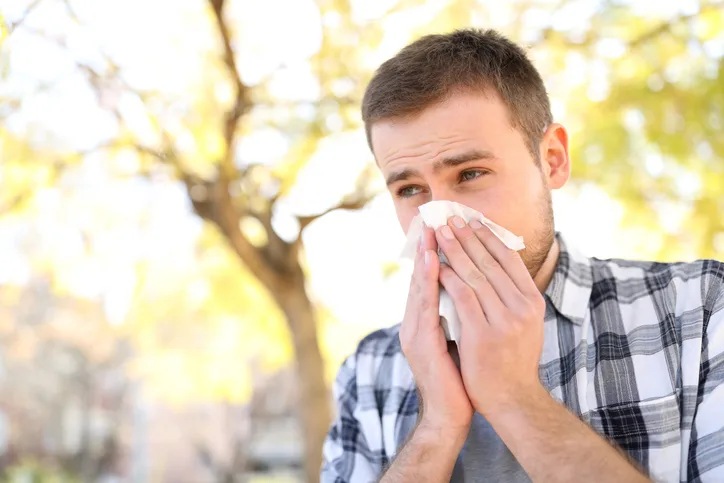
The top allergies affecting Canadians
Here's how to narrow allergy season down.

The snow has melted, temperatures are milder, birds are chirping, and daylight hours are longer — all visible signs of spring. But for allergy sufferers, it also means itchy, watery eyes, non-stop sneezing, and noses either congested or running so much, an industrial-sized box of tissues a day isn't cutting it.
Seasonal allergies strike at different times of the year, depending on which allergens trigger a reaction, while environmental allergies can be found all year round.
According to Dr. Harold Kim, president of the Canadian Society of Allergy and Clinical Immunology, the top environmental allergies affecting Canadians are, "grass, tree and ragweed pollens, molds, dust mites, and cats and dogs."
Those who are allergic to tree pollen typically suffer the worst in the spring, grass sufferers get it worse in late spring and summer, and ragweed blooms later in the year, causing symptoms to hit hard in late summer to fall.
"[Allergies] occur when our immune system overreacts to these proteins [and produces] antibodies called Immunoglobulin E (IgE)," explains Dr. Kim. "These antibodies lead to a release of chemicals from allergy cells in our body." And that causes an allergic reaction.
Aside from the aforementioned irritated eyes and nose, Dr. Kim adds that asthma symptoms like wheezing, coughing, and shortness of breath can occur as well. Identifying the allergens you suffer from is the first step in coming up with a treatment plan. And you don’t have to go as far as living in an actual bubble; there are realistic ways to alleviate the symptoms.
Aside from keeping the windows closed and pumping the air conditioning, Dr. Kim suggests "using medications like nasal anti-inflammatory sprays, antihistamines, and/or anti-allergy eye drops. If there is asthma, inhalers may be required."

While there's no way to predict "a 'bad' allergy season," Dr. Kim believes "with global warming, the outdoor allergy seasons will be longer."
The misery that comes from seasonal allergies typically ends when the first frost hits, but that doesn't mean allergy sufferers are in the clear once winter arrives. There's mold, which thrives in wet environments, making things especially worse during the damp-weather months. Those who are allergic can experience trouble breathing, coughing, sneezing and itchy skin.
Then there are pet allergies. If you've had no exposure to animals, then go to a home with pets, or commute to work and find yourself seated next to a person with dander or fur on their clothing, it can mean itchy, sneezy, wheezy symptoms, along with hives, for some. Basically, not a fun situation.
And, finally, dust mites can commonly be found in mattresses and other furniture in your home. Symptoms may be worse during the summer as the microscopic bugs are partial to warm, humid environments.
But what about those months in between, before the muggy temperatures arrive when the weather is finally warm enough to crack the windows wide open and air out the mustiness of winter? Is it worth the suffering? Definitely. Because you don't necessarily have to be in agony. A nasal spray, antihistamine or other medication, can easily help you get a better handle on your symptoms - and allow you to scale down from that giant box of tissues to a regular-sized one.
ALLERGENS ACROSS CANADA
Coastal British Columbia
Tree pollen When: Early February until mid-July What: Alder, birch, poplar; elm and oak may also contribute
Grass pollen When: End of April/beginning of May until September
Interior British Columbia
Tree pollen When: Late March until mid-July What: Birch, poplar, willow
Grass pollen When: Beginning of May in the southern part of the province; beginning of June in the Northern parts
Prairies
Tree pollen When: First week of April until June What: Birch and poplar; alder, maple, elm, oak, ash, and willow may also contribute
Grass pollen When: Mid-may until end of September
Ontario and Quebec
Tree pollen When: Early April until June in Southern Ontario and Quebec; may occur four-six weeks later in northern regions What: Mulberry, maple, box elder, poplar, willow, oak, beech, birch, alder and ash in Southern Ontario; birch and poplar in Northern Ontario; ash, poplar and birch in Quebec
Grass pollen When: Mid-to-late May until mid-June; may occur a couple weeks later in the northern regions
Weeds When: Early-mid August until the first frost What: Ragweed
Maritimes
Tree pollen When: Late March until the end of June What: Birch, poplar
Grass pollen When: Mid-May until the end of September
Weeds When: Early August until the end of September What: Ragweed
This article is based on an interview conducted by Denette Wilford on behalf of The Weather Network with Dr. Harold Kim, President of the Canadian Society of Allergy and Clinical Immunology, an expert in allergic rhinitis, on March 28, 2019.
Sources: Dr. Harold Kim, president of the Canadian Society of Allergy and Clinical Immunology